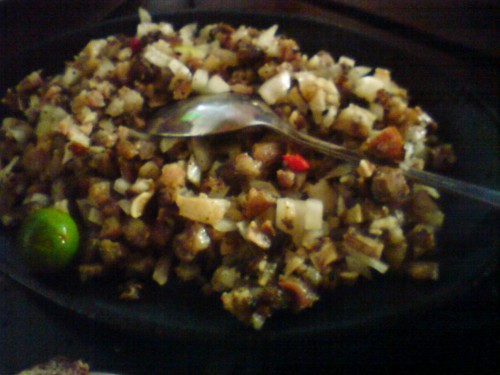pandesal (small bread rolls)
kesong puti (white cheese)
champorado (chocolate rice porridge)
sinangag (garlic fried rice)
and meat—such as tapa, tocino, longganisa.
Other examples include variations using a silog suffix, usually some kind of meat served with sinangág and itlog (egg). The three most commonly seen silogs are tapsilog (having tapa as the meat portion), tocilog (having tocino as the meat portion), and longsilog (having longganisa as the meat portion). An establishment that specializes in such meals is called a tapsihan or "tapsilugan".
 |
| Tapsilog |
 |
| Tocilog |
 |
| Longsilog |
Merienda
Merienda is taken from the Spanish and is a light meal or snack especially in the afternoon, similar to the concept of afternoon tea. If the meal is taken close to dinner, it is calledmerienda cena, and may be served instead of dinner.
Pulutan
Pulutan (from the Filipino word pulutin which literally means "something that is picked up") is a term roughly analogous to the English term "finger food". It originally was a snack accompanied with liquor or beer but has found its way into Philippine cuisine as appetizers or, in some cases, main dishes, as in the case of sisig.
Deep fried pulutan include chicharon (also spelled tsitsaron), pork rinds that have been salted, dried, then fried; chicharong bituka, pig intestines that have been deep fried to a crisp; chicharong bulaklak, similar to chicharong bituka it is made from mesenteries of pig intestines and has a bulaklak or flower appearance; and chicharong manok, chicken skin that has been deep fried until crisp.
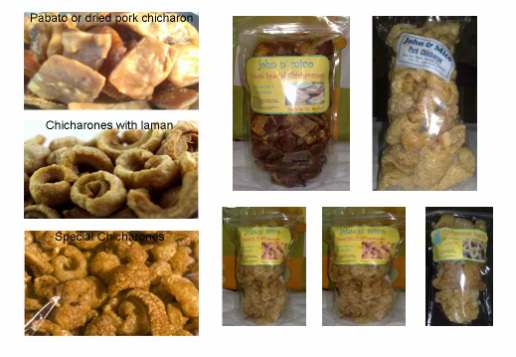 |
| Variation of Chicharon |
Regional specialties
 |
| Bagoong |
 |
| Pinakbet |
The Philippine islands are home to various ethnic groups resulting in varied regional cuisines.
The Igorots prefer roasted meats, particularly carabao meat, goat meat, and venison.
Due to its mild, sub-tropical climate, Baguio, along with the outlying mountainous regions, is renowned for its produce. Temperate-zone fruits and vegetables (strawberries being a notable example) which would otherwise wilt in lower regions are grown there. It is also known for a snack called sundot-kulangot which literally means "poke the booger." It's actually a sticky kind of sweet made from milled glutinous rice flour mixed with molasses, and served insidepitogo shells, and with a stick to "poke" its sticky substance with.
The town of Calasiao in Pangasinan is known for its puto, a type of steamed rice cake.
Bicol is known for its very spicy Bicol express. The region is also the well-known home of natong also known as laing or pinangat (a pork or fish stew in taro leaves). And mostly, they often use coconut on their dishes.
 |
| Bicol express |
 |
| Laing |
 |
| Pinangat |
Cainta in Rizal province east of Manila is known for its Filipino rice cakes and puddings. These are usually topped with latik, a mixture of coconut milk and brown sugar, reduced to a dry crumbly texture. A more modern, and time saving alternative to latik are coconut flakes toasted in a frying pan.
 |
| Latik |
Antipolo, straddled mid-level in the mountainous regions of the Philippine Sierra Madre, is a town known for its suman and kasoy or cashew products.
 |
| Kasoy |
Laguna is known for buko pie (coconut pie) and panutsa (peanut brittle).
 |
| Buko pie |
 |
| Panutsa |
Batangas is home to Taal Lake, a body of water that surrounds Taal Volcano. The lake is home to 75 species of freshwater fish. Among these, the maliputo and tawilis are two not commonly found elsewhere. These fish are delicious native delicacies. Batangas is also known for its special coffee, kapeng barako.
 |
| Kapeng Barako |
Bacolod is known for chicken "inasal" which is a kind of roast chicken served on skewers.
 |
| Chicken Inasal |
Iloilo is known for La Paz batchoy, pancit molo, dinuguan or pork blood stew, puto, biscocho and piyaya/piaya.
 |
La paz batchoy
Disclaimer: this photo is taken from Flavoursofiloiloblogspot.com |
 |
| Pancit molo |
Cebu is known for its lechón. Lechon prepared "Cebu style" is characterized by a crisp outer skin and a moist juicy meat with a unique taste given by a blend of spices. Cebu is also known for sweets likedried mangoes and dried fish.
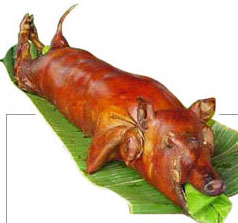 |
| Lechon |
 |
| Dried mango |
 |
| Variation of Dried fish (salted or unsalted) like: squid, danggit and dilis. |
Main dishes
Adobo is one of the most popular Filipino dishes and is considered unofficially by many as the national dish. It usually consists of pork or chicken, sometimes both, stewed or braised in a sauce usually made from vinegar, cooking oil, garlic, bay leaf, peppercorns, and soy sauce.
 |
| Chicken pork adobo |
Bistek, also known as "Filipino beef steak," consists of thinly sliced beef marinated in soy sauce and calamansi and then fried in a skillet that is typically served with onions.
 |
| Bistek |
Crispy pata, pork knuckles (the pata)
 |
| Crispy pata |
Mechado, kaldereta, and afritada are Spanish influenced tomato sauce-based dishes that are somewhat similar to one another. In these dishes meat is cooked in tomato sauce, minced garlic, and onions.
 |
| Mechado |
Kaldereta can be beef but is also associated with goat. A bit spicy.
 |
| Kaldereta |
 |
| Afritada |
Sinigang is a popular dish in this category distinguished by its sourness. It is typically made with either pork, beef, chicken or seafood and made sour with tamarind or other suitable souring ingredients.
 |
| Sinigang na baboy/pork |
 |
| Sinigang na bangus/milkfish |
 |
| Sinigang na hipon/shrimp |
Another dish is tinola. It has large chicken pieces and green papaya slices cooked with chili, spinach, and moringa leaves in a ginger-flavored broth.
 |
| Tinola |
Nilagang baka is a beef stew made with cabbages and other vegetables.
 |
| Nilagang baka |
Arroz caldo which is a rice porridge cooked with chicken, ginger and sometimes saffron, garnished with spring onions (chives), toasted garlic.
 |
| Arroz caldo |
Another variant is goto which is an arroz caldo made with ox tripe.
 |
| Goto (both best serve with tokwa't baboy - fried tofu and pork) |
 |
| Tokwa't baboy |
For vegetarians, there is dinengdeng.
 |
| Dinengdeng |
 |
| Pinakbet |
A type of seafood salad known as kinilaw is made up of raw seafood such as fish or shrimp cooked only by steeping in local vinegar, with onions, spices and other local ingredients. It is comparable to the Peruvian ceviche.
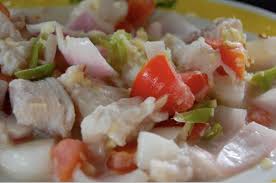 |
| Kinilaw |
Halo-halo - made with shaved ice, milk, and sugar with additional ingredients like coconut, halaya (mashed purple yam), caramel custard, plantains, jackfruit, red beans, tapioca and pinipig being typical. Ice candy made from juice or chocolate put it in a freezer to freeze is another treat. It can be any kind of flavor depending on the maker; chocolate and buko (coconut) flavored ice candy are two of the most popular.
 |
| Halo-halo |
 |
| Ice candy |
Street food and other snacks
Some grilled foods include barbecue isaw - chicken or pig intestines marinated and skewered.
 |
| Isaw |
Pork barbecue which is skewered pork marinated in a usually sweet blend.
 |
| Barbecue |
Betamax, salted solidified pork or chicken blood which is skewered.
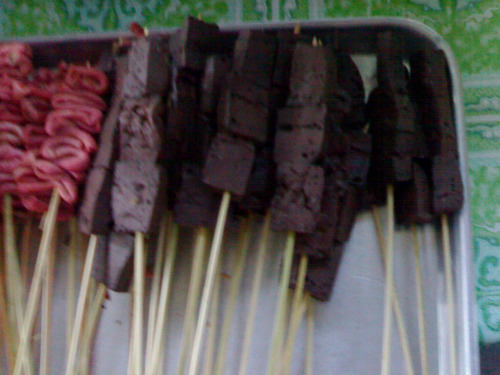 |
| Betamax |
Adidas which is grilled or sautéed chicken feet. And there is sisig a popular pulutan made from the pig's cheek skin, ears and liver that is initially boiled, then grilled over charcoal and afterwards minced and cooked with chopped onions, chillies, and spices.
 |
| Adidas |
Kwek-kwek also called “tukneneng,” this ball made of quail eggs and some orange batter is best eaten with lots of vinegar.
 |
| Kwek-kwek |
Fish ball - Fish meat that has been pressed and shaped into small balls are fried here, which is served on a stick, with a variety of dipping sauces.
 |
| Fishball |
Ice cream - Sorbetes (or, colloquially, "dirty ice cream" locally-produced usually with coconut milk as popularly called Pinoy sorbetes ice cream in flavors such as mango, cheese and yam).
 |
| Sorbetes |
Balut is a fertilized duck embryo that is boiled and eaten in the shell. Popularly believed to be an aphrodisiac and considered a high-protein, hearty snack. The ideal balut is actually about 17 days old. That is what's called "balut sa puti" ("wrapped in white").
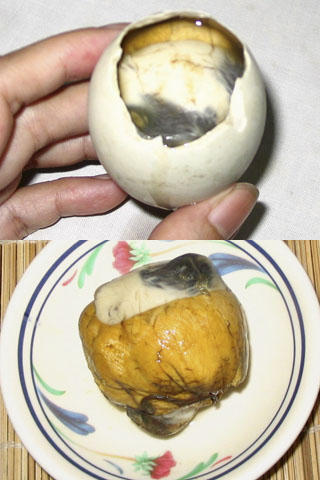 |
| Balut |
Taho, a type of soft beancurd served with syrup and tapioca balls is another snack.
 |
| Taho |




